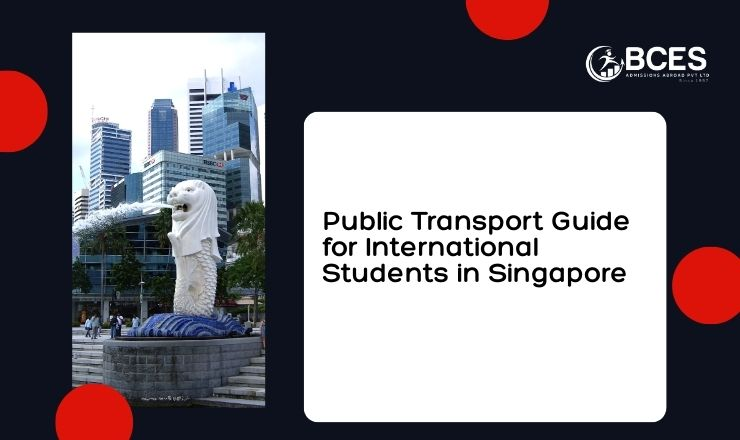Public Transport Guide for International Students in Singapore

04 September 2025
Studying in Singapore is more than the acquisition of a degree; it is the ability to experience life in one of the most exciting and advanced urban hubs on the planet. The foreign student usually faces a first challenge in learning to navigate the city with efficiency. Fortunately for them, the public transport system of Singapore is designed to be safe, affordable, and reliably high in standard. Depending on transporting themselves to class, exploring multiethnic neighborhoods, or enjoying the vibrant nightlife, the more they understand the transport system, the lesser their daily agenda becomes.
It has one among the world’s most sophisticated networked transport systems, led by the Land Transport Authority (LTA), with the network constantly upgraded to keep pace with contemporary student needs. Contactless payment options, real-time information through the use of cell phone apps, and perennial upgrades for seamless connection across the whole island are part of its modern advantages. Central to the network are the Mass Rapid Transit (MRT) system and bus network in Singapore, supplemented by taxis, ride-hailing services, and cycle paths for shorter distances.
Public transport, dominated by the MRT system, offers more attraction to students and is better when compared vis-a-vis travel. Trains are on time, clean, and fully air-conditioned, starting as early as dawn and stopping just before midnight. Stations are well marked in English, making navigation fairly straightforward for fresh travelers. Many important educational institutions, business areas, and residential districts are connected on this network, with many universities and colleges within walking distance of an MRT station. High-speed transit from island to island without getting stuck in traffic means precious time is saved for study and fun activities.
Buses complement the MRT system by covering routes that trains do not reach. They provide fascinating neighborhoods that you cannot get from elsewhere while being comfortable and reliable. It’s really easy; just scan your EZ-Link card, NETS FlashPay, or any contactless bank card, to pay for your ride. Singapore doubled its fleet of electric and hybrid buses in the year 2024, thus reinforcing its sustainability agenda while offering a quieter and smoother ride to commuters. This is an extra incentive for students to go for public transport rather than private ones and makes them feel good about Eco living portals.
Taxis and ride-hailing services like Grab can be practical substitutes during times when transportation is not available. In most cases, taxis and ridesharing services are more expensive than trains and buses but provide a layer of transportation for convenience and safety for students when returning from a late-night study group session or event. An emerging alternative that is becoming increasingly popular is cycling. As the government continues to develop existing public infrastructure to provide bike lanes/resources and bike-sharing schemes (SG Bike), cycling is becoming an accessible, cost-efficient mode of transport that also contributes to physical health while travelling short distances.
An important benefit for students is the provision of concessionary fares. Full-time international students attending accredited institutions have the opportunity to apply for student passes that considerably lower transportation expenses. These monthly travel passes facilitate an economical means for students to travel daily without the concern of excessive spending. For individuals who may not meet the qualifications, the pay-as-you-go system remains fairly priced and feasible.
The advancement of technology has significantly facilitated the process of navigating Singapore. Applications including MyTransport.SG, Citymapper, and Google Maps offer immediate updates regarding bus arrival times, MRT schedules, and fare estimations. For students who are acclimating to a new setting, these resources can alleviate the anxiety associated with determining routes and timings, thereby promoting punctuality for academic classes and various events.
In addition to its academic offerings, Singapore’s transportation infrastructure facilitates comprehensive exploration of the city’s diverse attractions. The network provides convenient access to cultural sites, including Chinatown and Little India, as well as entertainment hubs like Clarke Quay and notable tourist destinations such as Sentosa and Marina Bay Sands. Consequently, international students can fully engage in the vibrant lifestyle of Singapore without relying on private vehicles. The efficient connectivity contributes to a perception of the city as smaller and more accessible, enabling students to deeply immerse themselves in its multicultural setting.
At BCES Admissions Abroad, we assist students not only in gaining admission to prestigious institutions but also in facilitating their adjustment to life in a foreign country. One example of our guidance includes helping students understand how to utilize public transportation, which is among the various strategies we employ to ensure they can acclimate seamlessly and concentrate on what truly matters—namely, their education and future prospects.
Frequently Asked Questions (FAQs)
Indeed, public transportation is economically advantageous, particularly for students who acquire monthly concession passes. Such passes provide unrestricted travel on the MRT and buses at a reduced fare.
Full-time students in government-approved institutions are eligible for concession passes. However, part-time students may need to rely on standard adult fares.
Most students use EZ-Link cards or contactless-enabled debit and credit cards. Simply tapping in and out at gates or buses ensures smooth and fast payment.
Definitely. MyTransport.SG and Google Maps are among the tools that simplify trips by enabling easier scheduling, viewing real-time timings, as well as determining the shortest distance.
MRT and bus services usually run until midnight. After that, students can use taxis or Grab for late-night travel.
Indeed, all signage related to public transportation is presented in English, and announcements are communicated in several languages, including English, Mandarin, Malay, and Tamil, thereby ensuring that international students will not encounter challenges.